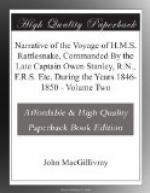3.
Brierly Island : paihe-tuan.
Cook’s New Caledonia : wa-teen.
La Billardiere’s New Caledonia : oua-tguien.
4.
Brierly Island : paihe-pak.
Cook’s New Caledonia : wa-mbaeek.
La Billardiere’s New Caledonia : oua-tbait.
5.
Brierly Island : paihe-lima.
Cook’s New Caledonia : wa-nnim.
La Billardiere’s New Caledonia : oua-nnaim.
6.
Brierly Island : paihe-wona.
Cook’s New Caledonia : wa-nnim-geeek.
La Billardiere’s New Caledonia : oua-naim-guik.
7.
Brierly Island : pahe-pik.
Cook’s New Caledonia : wa-nnim-noo.
La Billardiere’s New Caledonia : oua-naim-dou.
8.
Brierly Island : paihe-wan.
Cook’s New Caledonia : wa-nnim-gain.
La Billardiere’s New Caledonia : ou-naim-guein.
9.
Brierly Island : paihe-siwo.
Cook’s New Caledonia : wa-nnim-baeek.
La Billardiere’s New Caledonia : oua-naim-bait.
10.
Brierly Island : paihe-awata.
Cook’s New Caledonia : wa-nnoon-aiuk.
La Billardiere’s New Caledonia : oua-doun-hic.
The Redscar Bay numerals are equally instructive. They take two forms: one with, one without, the prefix in ow, as recorded by Mr. Macgillivray.
This system of prefix is not peculiar. The Tanna and Mallicollo numerals of Cook are:
COLUMN 1: ENGLISH.
COLUMN 2: TANNA.
COLUMN 3: MALLICOLLO.
One : r-eedee : tsee-kaee
Two : ka-roo : e-ry.
Three : ka-har : e-rei
Four : kai-phar : e-bats
Five : k-reerum : e-reeum
Six : ma-r-eedee : tsookaeee
Seven : ma-ka-roo : gooy
Eight : ma-ka-har : hoo-rey
Nine : ma-kai-phar : good-bats.
Ten : ma-k-reerum : senearn.
Here, although the formations are not exactly regular, the prefixion of an initial syllable is evident. So is the quinary character of the numeration. The prefix itself, however, in the Tanna and Mallicollo is no labial, as in the Louisiade and New Caledonian, but either k or a vowel.
The next fact connected with the Louisiade vocabularies is one of greater interest. Most of the names of the different parts of the body end in da. In the list in question they were marked in italics; so that the proportion they bear to the words not so ending was easily seen. Now it is only the words belonging to this class that thus terminate. Elsewhere the ending da is no commoner than any other.
What does this mean? If we look to such words as mata-da = eyes, sopa-da = lips, maka-da = teeth, and some other naturally plural names, we should infer that it was a sign of number. That this, however, is not the case is shown by the equivalents to tongue, nose, and other single members where the affix is equally common. What then is its import? The American tongues help us here:
COLUMN 1: ENGLISH.
COLUMN 2: MBAYA.
COLUMN 3: ABIPONI.
COLUMN 4: MOKOBI.




